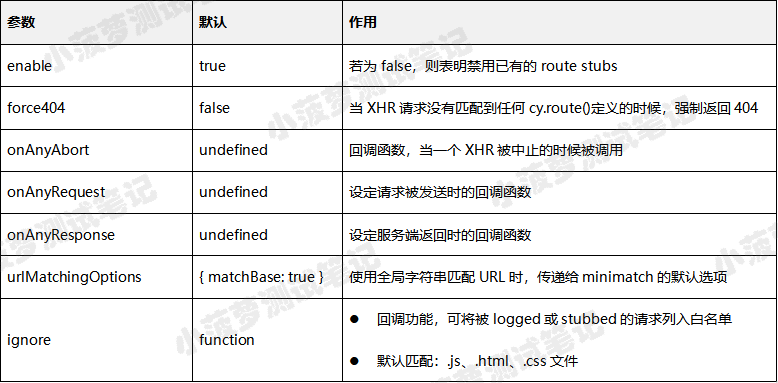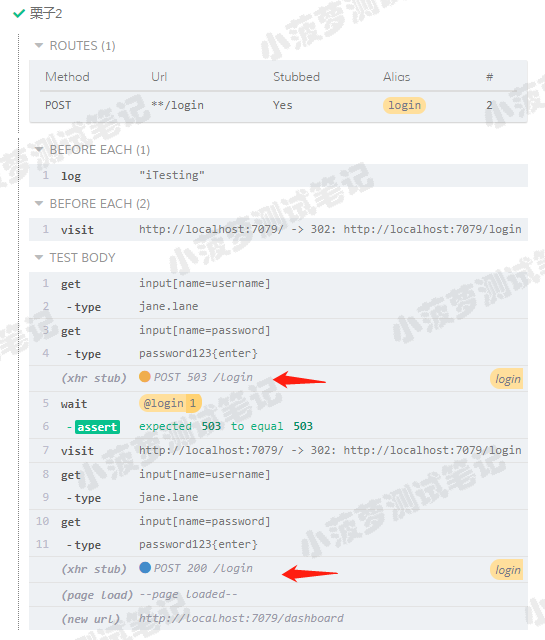如果想从头学起Cypress,可以看下面的系列文章哦
https://www.cnblogs.com/poloyy/category/1768839.html
前言
- Cypress 6.0.0 开始不推荐使用 cy.server() 和 cy.route()
- 在将来的版本中,对 cy.server() 和 cy.route() 的支持将移至插件
- 现在优先考虑使用 cy.intercept()
作用
- 启动服务器以开始将响应路由到 cy.route() 并更改网络请求的行为
- 前置知识:熟悉 .route() 命令,https://www.cnblogs.com/poloyy/p/13852941.html
语法格式
cy.server()
cy.server(options)
options 参数
作用
- 作为默认值,它们被合并到 cy.route() 中
- 作为所有请求的配置行为
以下选项被合并为 cy.route() 的默认选项

以下选项控制服务器,将会影响所有请求的行为

命令执行结果
- 执行结果是 null
- 且后续不能再链接其他命令
没有参数的栗子
// 启动服务器 cy.server()
- 任何与 cy.route() 不匹配的请求都将传递到服务器,除非设置了 force404,这样请求变成 404 和拿到一个空 response
- 与 options.ignore 函数匹配的任何请求都不会被记录或存根(logged、stubbed)
- 将在命令日志中看到名为(XHR Stub)或(XHR)的请求
带有参数的栗子
进入演示项目目录下
注:演示项目是 cypress 提供的,如何下载可看 Cypress 系列文章的一开始几篇都有写
cd C:UsersuserDesktoppycypress-example-recipesexampleslogging-in__xhr-web-forms
启动演示项目
npm start
浏览器访问项目
http://localhost:7079/
测试代码
context('route 的栗子', function () { const username = 'jane.lane' const password = 'password123' before(function () { cy.visit('http://localhost:7079/') }) it('栗子1', function () { cy.server({ method: 'POST', status: 503, delay: 1000, headers: { 'x-token': 'abc-123-foo-bar' } }) cy.route({ url: '**/login', response: { success: false, data: 'Not success' }, }).as("login") cy.get("input[name=username]").type(username) cy.get("input[name=password]").type(`${password}{enter}`) cy.wait('@login').then((res) => { cy.log(res) expect(res.status).to.eq(503) expect(res.responseBody.data).to.eq('Not success') expect(res.responseHeaders).to.have.property('x-token', 'abc-123-foo-bar') }) }); })
测试结果

启动服务器,关闭服务器的栗子
测试代码
it('栗子2', function () {
cy.server()
cy.route({
url: '**/login',
method: 'POST',
status: 503,
response: {
data:"success"
}
}).as("login")
cy.get("input[name=username]").type(username)
//第一次发出请求
cy.get("input[name=password]").type(`${password}{enter}`)
cy.wait('@login').then((res) => {
expect(res.status).to.eq(503)
// 关闭服务器
cy.server({
enable: false
})
})
cy.visit('http://localhost:7079/')
cy.get("input[name=username]").type(username)
//第二次发出请求
cy.get("input[name=password]").type(`${password}{enter}`)
});
测试结果

第二个请求虽然被路由监听到了,但是因为服务器关闭了,所以并没有获取路由的 status、response
注意事项
- 可以在启动 cy.visit() 之前启动服务器 cy.server()
- 通常,应用程序在加载时可能会立即发出初始请求(例如,对用户进行身份验证)
- Cypress 可以在 cy.visit() 之前启动服务器并定义路由( cy.route() )
- 下次访问时,服务器 + 路由将在应用程序加载之前立即应用